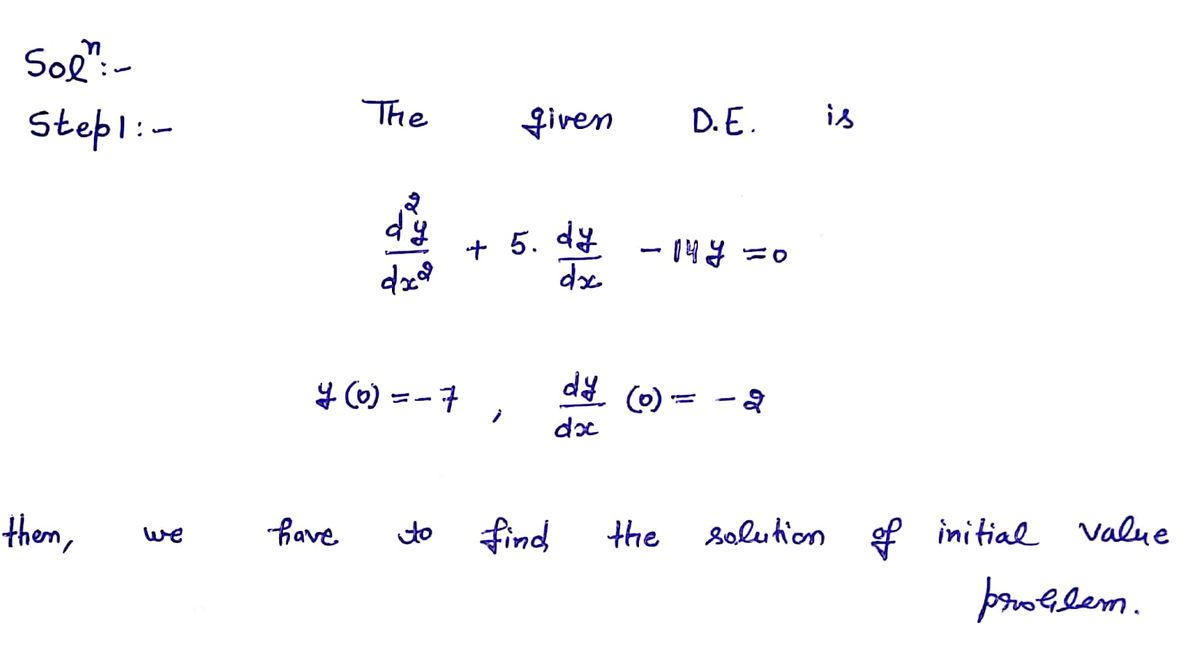The differential equation d²y +5dy - 14y dx² equation with roots = d'y dy +5. dx² dx 0 has characteristic = 0 help (formulas) help (numbers) Therefore there are two linearly independent solutions help (formulas) Note: Enter the solutions as a comma separated list (they should be those usual exponential ones as in the book). Use these to solve the initial value problem y(0) = −7, - 14y = 0, dy dx -(0) = -2
The differential equation d²y +5dy - 14y dx² equation with roots = d'y dy +5. dx² dx 0 has characteristic = 0 help (formulas) help (numbers) Therefore there are two linearly independent solutions help (formulas) Note: Enter the solutions as a comma separated list (they should be those usual exponential ones as in the book). Use these to solve the initial value problem y(0) = −7, - 14y = 0, dy dx -(0) = -2
Advanced Engineering Mathematics
10th Edition
ISBN:9780470458365
Author:Erwin Kreyszig
Publisher:Erwin Kreyszig
Chapter2: Second-order Linear Odes
Section: Chapter Questions
Problem 1RQ
Related questions
Question
2.2.8. Ordinary
![The differential equation
\[
\frac{d^2y}{dx^2} + 5 \frac{dy}{dx} - 14y = 0
\]
has characteristic equation
\[
\boxed{\phantom{---}} = 0 \quad \text{help (formulas)}
\]
with roots
\[
\boxed{\phantom{---}} \quad \text{help (numbers)}
\]
Therefore, there are two linearly independent solutions
\[
\boxed{\phantom{---}} \quad \text{help (formulas)}
\]
*Note: Enter the solutions as a comma-separated list (they should be those usual exponential ones as in the book).*
Use these to solve the initial value problem
\[
\frac{d^2y}{dx^2} + 5 \frac{dy}{dx} - 14y = 0, \quad y(0) = -7, \quad \frac{dy}{dx}(0) = -2
\]
\[
y(x) = \boxed{\phantom{---}} \quad \text{help (formulas)}
\]](/v2/_next/image?url=https%3A%2F%2Fcontent.bartleby.com%2Fqna-images%2Fquestion%2F4d6d6ec3-8d2a-4662-b20e-640089acaa34%2F6ef6c176-863b-42d1-9fea-734df6edd89e%2F76p6dtt_processed.png&w=3840&q=75)
Transcribed Image Text:The differential equation
\[
\frac{d^2y}{dx^2} + 5 \frac{dy}{dx} - 14y = 0
\]
has characteristic equation
\[
\boxed{\phantom{---}} = 0 \quad \text{help (formulas)}
\]
with roots
\[
\boxed{\phantom{---}} \quad \text{help (numbers)}
\]
Therefore, there are two linearly independent solutions
\[
\boxed{\phantom{---}} \quad \text{help (formulas)}
\]
*Note: Enter the solutions as a comma-separated list (they should be those usual exponential ones as in the book).*
Use these to solve the initial value problem
\[
\frac{d^2y}{dx^2} + 5 \frac{dy}{dx} - 14y = 0, \quad y(0) = -7, \quad \frac{dy}{dx}(0) = -2
\]
\[
y(x) = \boxed{\phantom{---}} \quad \text{help (formulas)}
\]
Expert Solution
Step 1: The given D. E. Is

Step by step
Solved in 3 steps with 4 images

Recommended textbooks for you

Advanced Engineering Mathematics
Advanced Math
ISBN:
9780470458365
Author:
Erwin Kreyszig
Publisher:
Wiley, John & Sons, Incorporated

Numerical Methods for Engineers
Advanced Math
ISBN:
9780073397924
Author:
Steven C. Chapra Dr., Raymond P. Canale
Publisher:
McGraw-Hill Education

Introductory Mathematics for Engineering Applicat…
Advanced Math
ISBN:
9781118141809
Author:
Nathan Klingbeil
Publisher:
WILEY

Advanced Engineering Mathematics
Advanced Math
ISBN:
9780470458365
Author:
Erwin Kreyszig
Publisher:
Wiley, John & Sons, Incorporated

Numerical Methods for Engineers
Advanced Math
ISBN:
9780073397924
Author:
Steven C. Chapra Dr., Raymond P. Canale
Publisher:
McGraw-Hill Education

Introductory Mathematics for Engineering Applicat…
Advanced Math
ISBN:
9781118141809
Author:
Nathan Klingbeil
Publisher:
WILEY

Mathematics For Machine Technology
Advanced Math
ISBN:
9781337798310
Author:
Peterson, John.
Publisher:
Cengage Learning,

